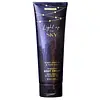What's inside
What's inside
 Key Ingredients
Key Ingredients

No key ingredients
 Benefits
Benefits

 Concerns
Concerns

 Ingredients Side-by-side
Ingredients Side-by-side

Water
Skin ConditioningCetyl Alcohol
EmollientStearyl Alcohol
EmollientParfum
MaskingCaprylic/Capric Triglyceride
MaskingCeteareth-20
CleansingDimethicone
EmollientGlyceryl Dilaurate
EmollientAloe Barbadensis Leaf Juice
Skin ConditioningDehydroacetic Acid
PreservativeAminomethyl Propanol
BufferingButyrospermum Parkii Butter
Skin ConditioningCocos Nucifera Oil
MaskingTheobroma Cacao Seed Butter
EmollientBenzyl Alcohol
PerfumingAcrylates/C10-30 Alkyl Acrylate Crosspolymer
Emulsion StabilisingWater, Cetyl Alcohol, Stearyl Alcohol, Parfum, Caprylic/Capric Triglyceride, Ceteareth-20, Dimethicone, Glyceryl Dilaurate, Aloe Barbadensis Leaf Juice, Dehydroacetic Acid, Aminomethyl Propanol, Butyrospermum Parkii Butter, Cocos Nucifera Oil, Theobroma Cacao Seed Butter, Benzyl Alcohol, Acrylates/C10-30 Alkyl Acrylate Crosspolymer
Water
Skin ConditioningStearic Acid
CleansingCaprylic/Capric Triglyceride
MaskingGlyceryl Stearate
EmollientIsopropyl Palmitate
EmollientPEG-100 Stearate
Parfum
MaskingGlycerin
HumectantCetyl Alcohol
EmollientDimethicone
EmollientSimmondsia Chinensis Seed Extract
AbrasiveSimmondsia Chinensis Seed Oil
EmollientButyrospermum Parkii Butter Extract
Skin ConditioningTheobroma Cacao Seed Butter
EmollientTocopheryl Acetate
AntioxidantDisodium EDTA
Xanthan Gum
EmulsifyingCarbomer
Emulsion StabilisingSodium Hydroxide
BufferingPhenoxyethanol
PreservativeChlorphenesin
AntimicrobialO-Cymen-5-Ol
AntimicrobialWater, Stearic Acid, Caprylic/Capric Triglyceride, Glyceryl Stearate, Isopropyl Palmitate, PEG-100 Stearate, Parfum, Glycerin, Cetyl Alcohol, Dimethicone, Simmondsia Chinensis Seed Extract, Simmondsia Chinensis Seed Oil, Butyrospermum Parkii Butter Extract, Theobroma Cacao Seed Butter, Tocopheryl Acetate, Disodium EDTA, Xanthan Gum, Carbomer, Sodium Hydroxide, Phenoxyethanol, Chlorphenesin, O-Cymen-5-Ol
Ingredients Explained
These ingredients are found in both products.
Ingredients higher up in an ingredient list are typically present in a larger amount.
This ingredient is an emollient, solvent, and texture enhancer. It is considered a skin-softener by helping the skin prevent moisture loss.
It helps thicken a product's formula and makes it easier to spread by dissolving clumping compounds.
Caprylic Triglyceride is made by combining glycerin with coconut oil, forming a clear liquid.
While there is an assumption Caprylic Triglyceride can clog pores due to it being derived from coconut oil, there is no research supporting this.
Learn more about Caprylic/Capric TriglycerideCetyl Alcohol is a fatty alcohol. Fatty Alcohols are most often used as an emollient or to thicken a product.
Its main roles are:
Though it has "alcohol" in the name, it is not related to denatured alcohol or ethyl alcohol.
The FDA allows products labeled "alcohol-free" to have fatty alcohols.
Learn more about Cetyl AlcoholDimethicone is a type of synthetic silicone created from natural materials such as quartz.
What it does:
Dimethicone comes in different viscosities:
Depending on the viscosity, dimethicone has different properties.
Ingredients lists don't always show which type is used, so we recommend reaching out to the brand if you have questions about the viscosity.
This ingredient is unlikely to cause irritation because it does not get absorbed into skin. However, people with silicone allergies should be careful about using this ingredient.
Note: Dimethicone may contribute to pilling. This is because it is not oil or water soluble, so pilling may occur when layered with products. When mixed with heavy oils in a formula, the outcome is also quite greasy.
Learn more about DimethiconeParfum is a catch-all term for an ingredient or more that is used to give a scent to products.
Also called "fragrance", this ingredient can be a blend of hundreds of chemicals or plant oils. This means every product with "fragrance" or "parfum" in the ingredients list is a different mixture.
For instance, Habanolide is a proprietary trade name for a specific aroma chemical. When used as a fragrance ingredient in cosmetics, most aroma chemicals fall under the broad labeling category of “FRAGRANCE” or “PARFUM” according to EU and US regulations.
The term 'parfum' or 'fragrance' is not regulated in many countries. In many cases, it is up to the brand to define this term.
For instance, many brands choose to label themselves as "fragrance-free" because they are not using synthetic fragrances. However, their products may still contain ingredients such as essential oils that are considered a fragrance by INCI standards.
One example is Calendula flower extract. Calendula is an essential oil that still imparts a scent or 'fragrance'.
Depending on the blend, the ingredients in the mixture can cause allergies and sensitivities on the skin. Some ingredients that are known EU allergens include linalool and citronellol.
Parfum can also be used to mask or cover an unpleasant scent.
The bottom line is: not all fragrances/parfum/ingredients are created equally. If you are worried about fragrances, we recommend taking a closer look at an ingredient. And of course, we always recommend speaking with a professional.
Learn more about ParfumTheobroma Cacao Seed Butter comes from the Theobroma cacoa, or Cacao tree. Cacao trees are native to tropical landscapes.
Like other plant butters, Cacao seed butter is an emollient. Emollients help soothe and soften your skin. By creating a barrier to trap moisture in, emollients help keep your skin hydrated.
Cacao seed butter contains antioxidants known as polyphenols. Antioxidants help fight free-radical molecules by stabilizing them. Unstable free-radicals may cause damage to your skin cells. Antioxidants may help with anti-aging.
Theobroma Cacao Seed Butter can be bad for acne prone skin.
Learn more about Theobroma Cacao Seed ButterWater. It's the most common cosmetic ingredient of all. You'll usually see it at the top of ingredient lists, meaning that it makes up the largest part of the product.
So why is it so popular? Water most often acts as a solvent - this means that it helps dissolve other ingredients into the formulation.
You'll also recognize water as that liquid we all need to stay alive. If you see this, drink a glass of water. Stay hydrated!
Learn more about Water